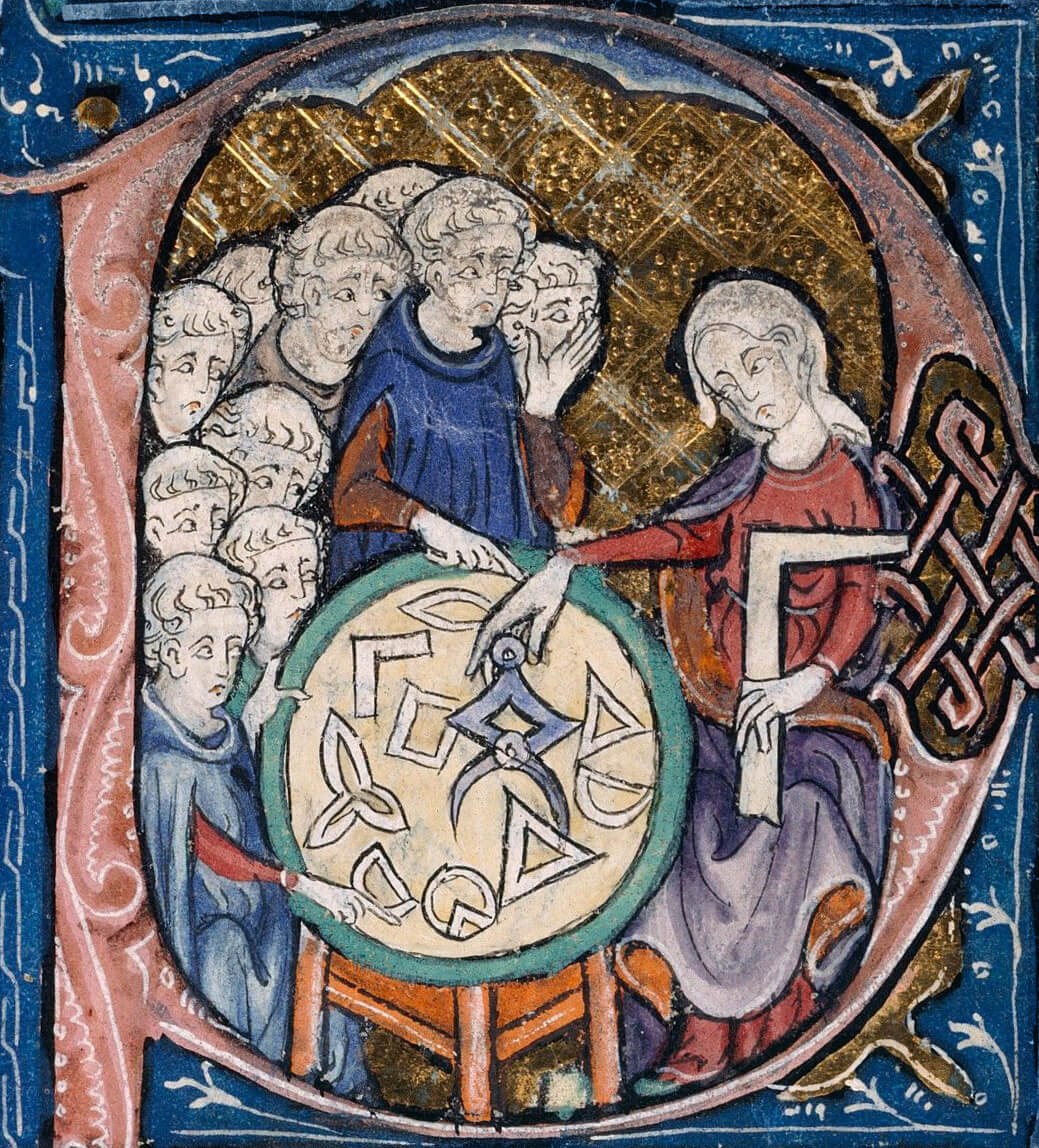In lecture-mode courses, the instructor just lectures---just like in the Middle Ages.
-
"Detail of a scene in the bowl of the letter 'P' with a woman with a set-square
and dividers; using a compass to measure distances on a diagram. In her left
hand she holds a square, an implement for testing or drawing right angles.
She is watched by a group of students. In the Middle Ages, it is unusual to see women
represented as teachers, in particular when the students appear to be monks.
She may be the personification of Geometry. Illustration at the beginning
of Euclid's Elementa, in the translation attributed to Adelard of Bath."---User: Leinad-Z:
Linked source: Wikipedia.
And for some students, it's always worked well.
But lots of evidence---or so it's claimed by people I ought to trust---show that on average lecture-mode courses are less effective than activity-mode courses. See Eric Mazur, ``Farewell, Lecture?'', 2009, Science, 323, 50.
Yours truly is even experienced at teaching activity-mode courses---but that was at a place where everything was laid out for me.
We are going to run this course as an activity-mode course.
In an activity-mode course, there are various activities that fill up the lecture period of which a short lecture (a micro-lecture) is only one.
Let's describe the standard day which shows how OUR activity-mode course goes.
Standard Day:
- Everyone sits in the first 4 rows.
- There is an assigned reading which will usually be 2 or 3 sections of
Serway or whatever textbook we use.
The reading MUST be done prior to class.
A complete chapter will usually take 3 or 4 lecture days.
- There will be a 5-minute quizz to start the lecture period.
-
The first question on the quizz will be ``Have you done the reading for the day?''
The right answer is yes.
The second question will be ``Have you checked the example calculations in the reading?'' The right answer is yes. Don't image the instructor has done this---``do as I say, not as I do''.
The third question will be ``Have you a question of the day for your activity group or the instructor?'' The right answer is yes.
There might be 1 to 3 further easy multiple-choice questions on the reading.
The quizzes count 10% of the total grade. All quizzes count the same no matter how many questions they contain.
There is one regular drop for the quizzes.
Special drops for illness or attending university activities will be given.
Since the activity-mode course involves participation, attendance is marked by means of the daily quiz.
- The instructor will then give a 15--20 minute micro-lecture on that part of
the reading he judges to need some amplification and takes some student questions of
the day. There might be a
demonstration.
- The micro-lecture is NOT on the complete reading and will not introduce
basic material from reading.
The student is responsible for being ready tor the micro-lecture
and understanding the rest of the reading
on their own or from other sources: e.g., the student's group, the instructor in class, the
instructor out of class
(see instructor's schedule), the recitations,
the TAs in EP 309,
a TAAP group.
- There will be a group work period wherein
activity groups will work together on problems---usually 3 or so---that the instructor assigns
from the textbook that correspond to the reading.
Eveyone in the group has to bring their
textbook to class---yes, I know it
weighs a megagram---but
you will need it to get the group problems and for reference when doing them.
How the group work done? There is no one way. Each group might evolve their own procedure. But there are some ideas.
- Everyone reads a problem and people suggest the right concept
to apply.
- The right concept often corresponds to an equation.
Find the equation.
- The solution is by then identifying the knowns and
unknowns and doing the algebra.
Sometimes identifying the knowns and unknowns will
identify the equation to use.
- Doing 1-digit algebra without a calculator is often the fastest
way.
- Students can race each other and compare calculated answers.
- Another approach is for each student to tackle a different
problem and then solve it and explain it to the others in the group.
Questions of the day and homework problems can also be discussed during the group activity period.
It's the student's responsibility to participate actively in the groups and not let your colleagues down.
The group activity is social and fun---this is a requirement---but it's business---keep your mind and discussion on the issues.
The groups will consist of 2 to 4 adjacent persons and we'll set them up on the first day. You can change groups if you like as we go on.
Group work should take 15--20 minutes.
- Everyone reads a problem and people suggest the right concept
to apply.
- To finish the day, the instructor will
take up final questions which
involve one or more of working one of the textbook problems,
working a homework problem,
or answering a question of the day.
The instructor will also assign the reading for next day.
The last phase will probably be the last 10 minutes or so of the day.
The transitions between the activities of the period is to be quick---remember the period is all business.
We start on time, we end on time.
